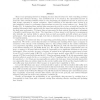Free Online Productivity Tools
i2Speak
i2Symbol
i2OCR
iTex2Img
iWeb2Print
iWeb2Shot
i2Type
iPdf2Split
iPdf2Merge
i2Bopomofo
i2Arabic
i2Style
i2Image
i2PDF
iLatex2Rtf
Sci2ools
FOCS
2000
IEEE
2000
IEEE
Opportunistic Data Structures with Applications
There is an upsurging interest in designing succinct data structures for basic searching problems (see [23] and references therein). The motivation has to be found in the exponential increase of electronic data nowadays available which is even surpassing the significant increase in memory and disk storage capacities of current computers. Space reduction is an attractive issue because it is also intimately related to performance improvements as noted by several authors (e.g. Knuth [15], Bentley [5]). In designing these implicit data structures the goal is to reduce as much as possible the auxiliary information kept together with the input data without introducing a significant slowdown in the final query performance. Yet input data are represented in their entirety thus taking no advantage of possible repetitiveness into them. The importance of those issues is well known to programmers who typically use various tricks to squeeze data as much as possible and still achieve good query ...
| Added | 31 Jul 2010 |
| Updated | 31 Jul 2010 |
| Type | Conference |
| Year | 2000 |
| Where | FOCS |
| Authors | Paolo Ferragina, Giovanni Manzini |
Comments (0)

